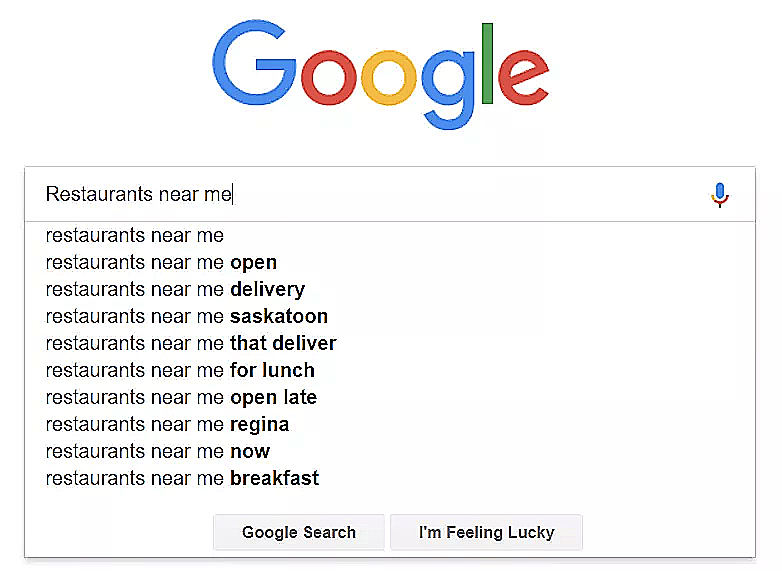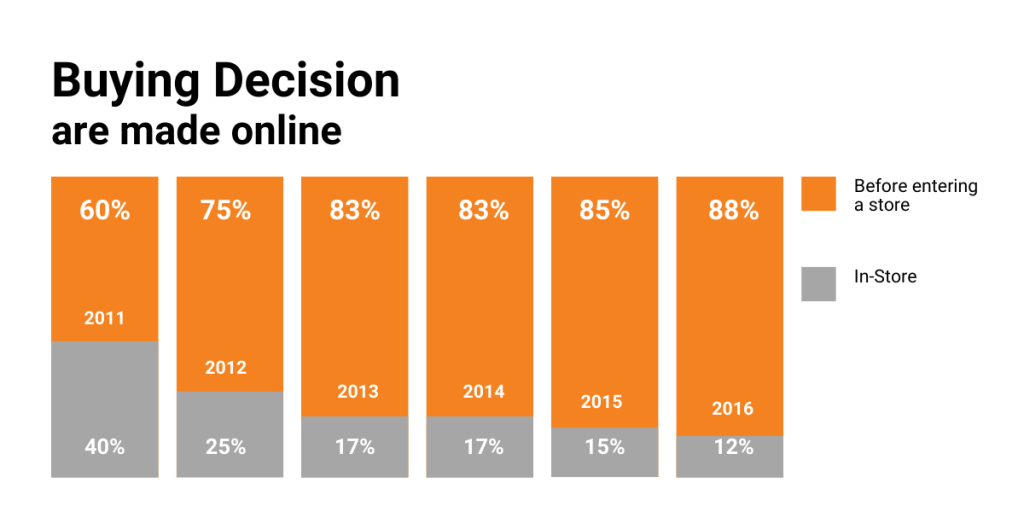Before making a purchase, customers have to take a few steps. We call these steps the “customer journey.” It’s important for you to know and understand this process, even if your customers are not aware of it. It can make a big difference in getting the sale or watching customers go to your competition.
So hop on board, and let’s explore the twists and turns of the customer journey!
Let’s take a trip through the 5 phases of the customer journey model:
- The first stop is Awareness. Customers need to know you exist before they can consider buying from you.
- Next up is Searchability. Once they know you exist, they need to be able to find you easily.
- Then we have Reputation. Customers want to make sure you’re trustworthy and have a good reputation before they do business with you.
- Buckle up for Conversion! This is where the magic happens – turning a prospect into a paying customer.
- Finally, we arrive at Advocacy. The most exciting destination of them all! When customers become your advocates, they spread the word about your business and bring in more customers.

If you’re ready to understand the customer journey in more detail, keep reading this blog, and don’t forget to download our FREE fillable PDF which will help you implement the steps below.
Let’s get started!
AWARENESS

Brand Awareness: Diving into the history
The customer journey model has evolved quite a bit as customers found new ways to discover local businesses. One thing that’s remained the same is the importance of the moment where your customer becomes aware of who you are. We call that awareness.
How businesses achieve brand awareness through marketing or advertising has transformed dramatically over the years.
Let’s take a look at how advertising has changed:
- In 1450 Johannes Gutenberg invented the printing press and opened the first-ever print shop in Germany. This brought us print newspapers (and the possibility of print ads).
- In 1867 billboards began to take off and only became more popular as time went on.
- In 1922 radio advertising made its debut. It was originally launched as a way to help stations keep up with the costs of improvements.
- In 1941 we added TV advertising to the mix! Fun Fact: The very first TV ad was purchased for only $9.
- In the 1980s marketing via telephone began to take off. In 1981, for the first time in history, telemarketing spending exceeded that of direct mail ads.
- In the mid-1990s search engine marketing emerged starting with Yahoo. Following shortly behind in 2000 Google launched AdWords and forever changed search engine marketing.
- In the early 2000s content marketing, also known as blogging took the world by storm. In the span of 7 years, we went from 23 published blogs to over 50 million!
- In 2004 MySpace was the first social network to reach 1,000,000 monthly users. In the years that followed we would see massive growth on social networks like Facebook, Twitter, YouTube, and Instagram.
- In the late 2000s email marketing really took off. This was after overcoming a slow start due to hesitation surrounding the Can-Spam legislation passed in 2003.
- Also, in the late 2000s, digital advertising experienced rapid growth. This included social media marketing, search engine optimization, and other online marketing strategies. This transition has continued up to the present day.
Today, local businesses are investing more in paid digital advertising. Platforms such as Google AdWords, Google Display, and Facebook Ads Manager are popular choices. These platforms provide advanced targeting capabilities and offer measurable performance metrics that enable us to evaluate a return on investment.
What are the changes in the customer journey model over time?
One significant factor that sets the old and new models apart is the role of search engines.

Search engines, such as Google, have given consumers an unprecedented level of convenience. They can now find exactly what they need quickly and easily. Nowadays, the majority of the customer journey happens at the consumer’s fingertips, whether on their mobile device or computer.
As noted earlier, a crucial aspect of the customer journey entails researching businesses online before making a purchasing decision. How do consumers go about this? The answer lies in the most popular and user-friendly tool available, Google. To effectively deal with the new buying decision model, sales professionals should adopt a needs-based selling approach.

Before the emergence of Google, the customer journey model was different from what we see today. The traditional approach involved a customer being lured to a brand or business through advertising. Then, the customer would make a purchase, which would be their “first moment of truth”. In conclusion, based on their personal experience, the consumer may express their opinion to others by talking about it.
This transactional process could be enhanced by sales teams adopting a needs-based selling approach.

The two models have something in common. Consumers go through a process when considering a product or service. This process includes becoming aware, gathering information, and deciding whether to buy or not. However, the difference lies in the way consumers acquire information during this process.
With Google, information is readily available, empowering consumers to compare products, services, and companies and make informed purchasing decisions.
Google coined the term “Zero Moment of Truth” (ZMOT) to describe the search and research phase of the customer journey. This concept, introduced in 2011, has provided a wealth of data on consumer behavior.

- Google’s 2016 ZMOT Stats show that 88% of U.S. consumers consider the “zero moment of truth” before they purchase something. This means they research and compare options before deciding what to buy.
- Consumers now consult 10.4 sources before making a purchase. This is twice as many sources as the previous year. These sources include both new media and traditional. (Google)
It’s crucial for local businesses to focus on their online presence, as it has become increasingly important to consumers worldwide.
Searchability

A local business needs to have a strong online presence because it is an essential part of the consumer journey. When a customer is looking for a product or service, they will likely conduct an online search. The businesses that are most easily found online are the ones that will succeed in today’s marketing world.
Suppose a customer is searching for a new laptop. They may start by searching for “best laptops for college students” on Google. From there, they will be looking for articles or advertisements that offer relevant information on laptops that meet their needs.
Once the customer has decided which laptop they want to purchase, they will move on to finding where the laptops are sold near them. They will likely use online business listings to find the location and contact information of retailers. This is why it is important to optimize your online listings. Without an optimized listing, the customer may not find you.
Reputation

When customers search for a local business online, they typically spend time researching the establishment before making a purchase. This includes reading online reviews and ratings to gauge the reputation and quality of the business.
If a customer comes across negative reviews, they may continue their search until they find a business they feel comfortable doing business with. As a result, local businesses need to be mindful of the impact that online conversations and reviews can have on their reputation and customer journey.
There are two popular channels that customers use to conduct research before making a purchase:
- Online Reviews
- Before transacting with a local business, consumers often check online reviews to gauge its reputation. Positive reviews can influence their decision to visit the business.
- Social Media
- A local business’s frequent and active engagement on social media can signal its commitment to providing good customer service and fostering consumer relationships.
A customer’s experience with your business can significantly impact the consumer journey for other potential customers. Negative experiences, in particular, are likely to be shared and can harm the profitability of the business if not addressed properly.

To avoid accumulating too many negative reviews, local businesses must be diligent in managing their reputation. If left unchecked, negative reviews can drive customers to seek out local competitors instead. By offering online review management services, businesses can not only improve their online reputation but also create a new revenue stream.

The impact of positive reviews on a local business cannot be overstated. A positive customer experience is the most effective form of marketing and can influence other potential customers to do business with the establishment.
Conversion

After researching a local business, customers are likely to be ready to make a purchasing decision. With many businesses offering e-commerce options on their websites, customers can easily make a purchase online.
Your website serves as the virtual storefront for a local business, and without one, the business is invisible to potential customers who are searching for their products/services online.
As more customers adopt online shopping, the significance of website presence and e-commerce options becomes more important. Even for customers who prefer to shop in-store, a website can provide valuable information such as the different brands and products available at the physical location. Therefore, having a website is crucial for local businesses, regardless of whether they choose to sell their products and services online or in-store.
Because your website is such a valuable part of the customer journey, it is important to install and optimize conversion tracking on your website. Conversion tracking is the process of monitoring the actions taken by web visitors that could lead toward the completion of a business goal.
Examples of conversion actions can include but are not limited to, signing up for your email list, downloading a piece of content offered on your site, adding an item to their cart, and of course making a purchase. Conversion tracking allows us to determine the effectiveness of your website and any paid marketing efforts.
Advocacy

After you have completed a sale, the customer journey does not stop. In an ideal world, your customers will return for future business, and even promote your business to others, advocating on your behalf.
To build that kind of advocacy you need to not only provide a stellar buying experience but continue to build a connection post-sale. Here are a few ways to connect with your customers and build a relationship, even after the sale:
- Create an online community, where your audience can connect with you and other loyal customers
- Engage with your audience online, looking for ways to build connections
- Look for opportunities to surprise and delight your customers
- Send out regular education and value to customers on your email list
- Survey your audience – and listen to what they have to say 😉
- Publish user-generated content, sharing your customers’ experience
Remember, when you build a relationship with your customers you have a higher chance to earn their business for life and broaden your potential customer pool to all the people they know.
Needs-based selling in the consumer journey
Needs-based selling is a customer-centric approach to sales that prioritizes the consumer journey. By conducting customer research, salespeople can identify a customer’s unique needs and pain points, enabling them to position their products and services in a way that resonates with the customer. Unlike transactional selling, needs-based selling is a relationship-building process that establishes a foundation of trust between the salesperson and the customer.
This approach allows sales professionals to stay top-of-mind with potential customers, even if they are not yet ready to make a purchase. By maintaining ongoing conversations and providing opportunities for the customer to learn more about the product or service, sales professionals can capitalize on the customer’s journey as they progress through it.
Needs-based selling is an agile approach that allows sales professionals to adjust their tactics as the customer’s needs change. This flexibility, coupled with the strong relationship between the salesperson and the customer, can lead to more closed deals and loyal customers who are connected to the sales professional, product, service, and company.
A presence at every step in the customer journey model
If you want to make sure that your business is truly engaged with your customers every step of the way, it’s important to have a strong presence in all areas of marketing and online visibility. This means being visible where your customers are and making sure you are always top of mind.
Whether you’re ready to hand over the reins of your marketing fully, or you just need a hand in a certain segment of your marketing, we’re here to help. Schedule a call with us today to start the conversation about how Boost Media Group can help you.
Frequently Asked Questions
What are the main steps in the customer journey?
The customer journey has five steps: Awareness, Search, Reputation, Conversion, and Advocacy. These steps guide customers from learning about your business to recommending it to others.
Why is it important to be searchable online?
Being easy to find online helps customers discover your business. The more visible your business is, the more likely customers are to find and choose you.
How can I manage my business’s reputation?
Monitor online reviews, engage on social media, and respond to feedback. Positive reviews and a good online presence build trust with customers.
What is conversion tracking, and why does it matter?
Conversion tracking is the process of watching actions like purchases or sign-ups on your website. It helps you understand how well your marketing is working.
What is needs-based selling, and how does it help sales?
Needs-based selling is about understanding what the customer needs and offering the right solution. This approach helps build trust and makes it easier to close sales.





